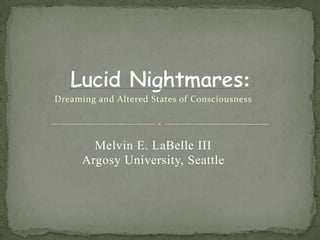
PSY492 PowerPoint Presentation
- 1. Lucid Nightmares: Dreaming and Altered States of Consciousness Melvin E. LaBelle III Argosy University, Seattle
- 2. Waking Consciousness and REM sleep dream consciousness interact and affect one another in a symbiotic relationship. Depending on emotional regulation dreams can heal and rejuvenate the mind or nightmares can deteriorate it Hypothesis
- 3. Primary consciousness can be defined as awareness of perception and emotion (Hobson, 2009) Secondary consciousness is defined by language skills, self-reflective awareness, abstract thinking, and metacognition (Revonsuo, Kallio, & Sikka, 2009) Most mammals in the Animal Kingdom display primary consciousness but only humans show signs of secondary consciousness (Hobson, 2009) States of Consciousness
- 5. From these activations dreams in REM sleep are longer, more vivid and hallucinogenic, and has more scene changes within the dream sequence (Bob, 2006)NREM sleep vs. REM sleep
- 6. MRI’s and EEG’s show the limbic forebrain structures and the amygdala are reactivated along with several other brain systems (Stickgold, Hobson, Fosse, & Fosse, 2001) The pons, midbrain and thalamus, amygdala, hypothalamus, and basal ganglia reactivate giving dreams more of a “realness” feeling to them (Hobson & Pace-Schott, 2002) Brain scans show abrupt shifts in neural activity during REM sleep that is related to the seemingly random “jumps” in scenes of the dream (Bob, 2006) Brain functions in REM sleep
- 7. 1. Dreams are a by-product of the self-organization of the mind that occurs in REM sleep (Bob, 2006) 2. Activation and recombination of memories allows for an altered state of reality to form within the brain (Stickgold, et al, 2001) *Both theories utilize that the re-activation of the visual cortex in REM sleep allows the images of the dream to be “watched” 3. Dreams are the creation of an evolutionary sub-consciousness, or “protoconsciousness” that the dreamer can then consciously experience (Hobson, 2009) Dream Theories
- 8. Nightmares are often correlated with emotional distress and stressful life events Most clinical disorders are linked with nightmares, especially those with trauma exposure and post-traumatic stress syndrome (PTSD) Depending on the individual’s capacity to regulate emotion and the amount of heightened distress in response to emotional stimuli, nightmares can range from an annoyance to a chronic disorder of fear and anxiety that has connection with psychopathology in waking consciousness (Levin & Nielson, 2009) The Effect of Nightmares
- 9. Lucid dreaming is when one becomes aware that one is asleep and is dreaming (Holzinger, 2009) Occurs when further activation of the frontal cortex allowing secondary consciousness, such as language and reasoning The difference of dreaming and lucid dreaming seems to lie in the dorsolateral prefrontal cortex (DLPFC) (Stickgold, et al, 2001) Lucid dreaming, while coined by Frederik Willems van Eeden in 1913, has been traced back to ancient history (Holzinger, 2009) Lucid dreams
- 11. Therapists can use the client’s self-reported dreams to access the mental state of the client based on the dream’s images, quality, and whether the client had a dream, bad dream, or a nightmare
- 12. Clients can ensure healthier sleep patterns by decreasing fear of nightmares
- 13. Lucid dreaming has not shown to decrease nightmare frequency, though it does decrease nightmare suffering(Holzinger, 2009) Lucid Dreaming as a Therapy Tool
- 14. Where do dreams form and what controls them? Is there a “protoconsciousness” creating the dreamscape, and if so, where is it located? How can dreams and nightmares be further used to diagnose the mental state and emotional regulation of the client? How does the DLPFC become reactivated in REM sleep? Can brain mapping during dreams help find the answer to the mind/body dilemma? Future Questions and Research
- 15. Waking Consciousness and REM sleep dream consciousness interact and affect one another in a symbiotic relationship. Depending on emotional regulation dreams can heal and rejuvenate the mind or nightmares can deteriorate it Hypothesis